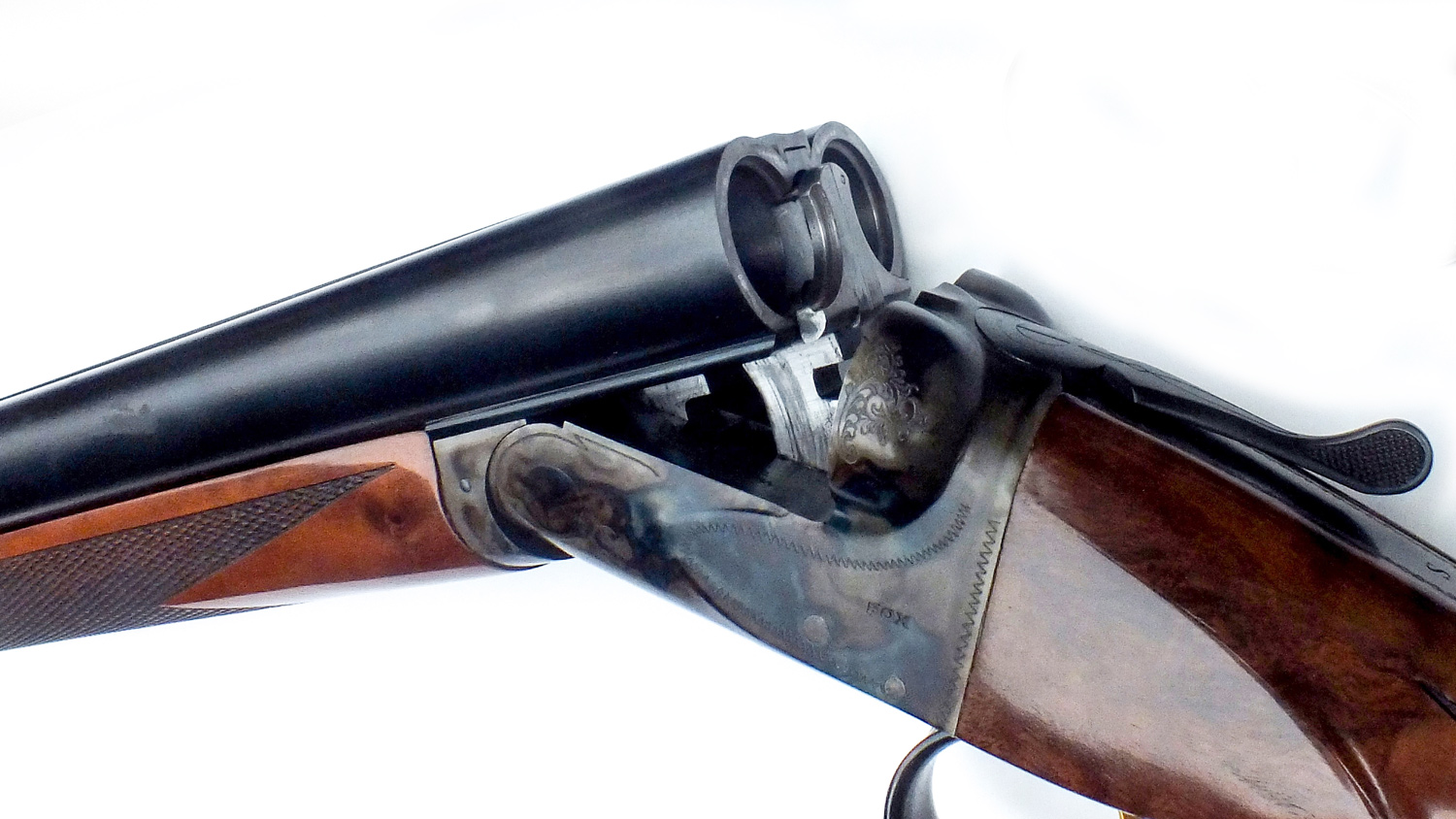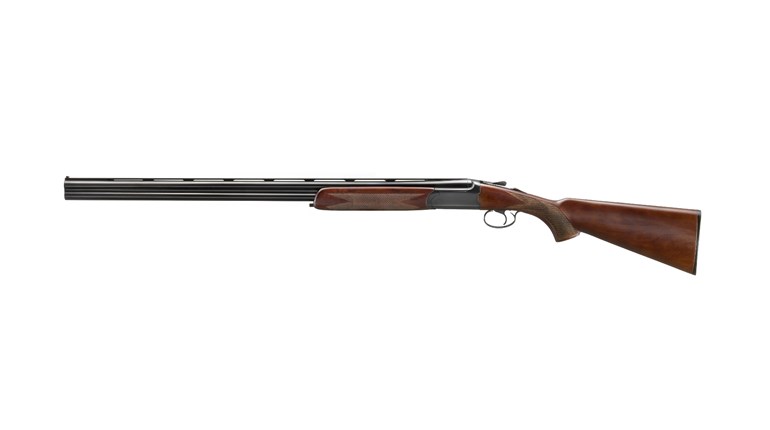
Since my youth, I’ve had a love affair with the classic side-by-side shotgun. My wife, Cherie, and I use side-by-sides almost exclusively for clay targets and hunting, including ducks and geese. Doubles are reliable, graceful, easy to carry in the field and pleasing to the eye. Of all the classic doubles, my favorite has always been the Fox shotguns made from 1904 to 1942. The company went through several owners with Savage Arms buying The Fox Gun Company in November of 1929. After the last true Fox guns were built, Savage branded an upgraded Stevens double barrel as the Fox Model B, but it was Fox in name only and shared none of its design or quality with the classic Fox. Most of my Foxes are the basic Sterlingworth model, but I’ve owned several graded guns.

With the exception of the base, Sterlingworth grade, Fox guns were graded alphabetically with A being the lowest grade model and F being the highest in adornment. Other grades H through X were based more on purpose rather than level of adornment. Fox shotguns were simple in design and rugged in construction. Their most attractive feature was a sculpted and diminutive receiver compared to other American guns of the day. They were remarkably simple and used coil springs, rather than traditional flat springs.

When I found out Savage was bringing out another version of the Fox, I was instantly interested. A cursory examination at SHOT Show revealed the new gun didn’t share the original rotary bolt design, but had a classic double-under bolt design without a rib extension. In reality, the new Fox A Grade is a version of the Connecticut Shotgun Company’s RBL model. Still, the new gun shares the classic Fox lines and high-quality finish.
Looks matter
In appearance, the new Fox A Grade resembles the Sterlingworth models I like so much. The side panels have the traditional sculpted curves, the receiver is compact and lightly engraved with the same border engraving as a Sterlingworth with a bit more adornment on fences. Unless you’re a Fox aficionado, you’ll not likely observe anything external that’s different.

Besides the locking system, there are numerous other differences to the original Fox guns, but changes from the original are all tried and true systems. The Anson and Deeley boxlock design is the most prolific of all boxlock shotgun systems, simple and reliable. The Southgate ejector system kicks empties out with authority and precision. Many interior parts and the double triggers are titanium nitride coated for wear resistance. The hinge pin is replaceable, though I can’t imagine ever needing that option. The safety, like most traditional side-by-sides, is automatic. The original Fox A grade used the Deeley style latch; the new Savage Fox A Grade uses the Anson method.
The original Fox guns didn’t use the modern through bolt method of attaching the stock to receiver, but the modern Fox does. The stock is nicely checkered and figured American Walnut with a pleasing finish that complements the rust blued barrels and color case-hardened receiver. The butt plate is hard plastic and identical in appearance to the standard plate on the original Fox guns. Barrels on my test gun were 28 inches with a swamped rib and five choke tubes.

Itching for a chance to wring the new gun out, I contacted Savage for a test gun and scheduled a trip to Friendsville, PA, for the 16th Northeast Side-by-Side Shotgun Classic held at Haussman’s Hidden Hollow. Haussmann’s Hidden Hollow is a privately-owned sporting clays location that caters primarily to classic shotguns and the 13 stations in the Classic’s event were both challenging and picturesque. We were blessed with low humidity, bright sunshine, and temperatures in the low 70s that made the day even more pleasant. The exhibition tent was filled with several million dollars of beautiful classic shotguns and accessories. There were old friends and friendly faces everywhere I looked.
This was my first chance to really try the new gun out on a wide variety of clay targets. It drew a lot of interest around the course and I did reasonably well with it, but I knew going into the adventure that I was going to have to compensate because the stock’s comb was a bit too high for me to get a proper gun mount.

On a shotgun, there’s no rear sight and if there was, there wouldn’t be time to line up a set of sights while tracking a target, establishing lead and getting off a shot on a fast-moving target. Because of this, how the gun fits the shooter is important. In effect, where the shooters eye is located serves as the rear sight. If your head is in the right place, you’ll be looking straight down the barrels and you’ll shoot where you look. If your head is in the wrong place, you have to compensate and therein lay my trouble. Apparently, I have an unusual facial construction and guns with lower dimensions fit me better. With the new Fox, my head was too high, making the gun shoot higher than where I was looking. In defense of Savage, most modern shooters like a higher comb than I, and for most shooters, the higher comb will be a blessing.
How does it shoot?

Shooting the new A Grade is a pleasure and more like shooting a classic British game gun than the Sterlingworth field grades I normally shoot. The triggers were crisp and the gun opened and closed with authority and precision. Everything about it indicated quality workmanship as it should on a gun at this price level. I did notice the wrist of the stock was a bit larger in diameter than the original A Grade Foxes and I suspect this has something to do with the through-bolted stock attachment. Recoil was more comfortable than the original guns because of the straighter stock. I used 1200 fps, 1⅛-ounce Federal Grand paper-hull loads. They crushed targets and smelled great when they came out of the gun.
In the first half of the course, every target except one was a falling target, meaning I needed to be in front of and below the target to break it. Because the gun was already shooting too high for me, I had to compensate. I had to guess how much lower I needed to be and my mind couldn’t make the calculation fast enough. I had trouble shooting far enough below the target to hit it.

Once we got to the second half of the course, most of the target presentations were of rising targets and while I still had to compensate, it was much easier. On the first half of the course I missed 18 of the first 40 targets. On the second half of the course, I missed only six, and in the last four stations of 24 targets, I only missed two shots. My finishing score was 56 out of 80 targets. With my gun that fits me, I normally shoot about 65, but most shooters would prefer the stock dimensions of the new A Grade better.
Available in both 12- and 20-gauge versions, the new Savage Fox A Grade shotgun is a beautiful and well-crafted firearm, and considering the level of workmanship it’s reasonably priced with an MSRP of $4,999. The fit and finish are superb, the triggers are crisp and consistent, it’s lively and responsive and the ejectors work perfectly. Unlike the aforementioned Fox Model B, this gun is truly good enough to carry on the rich tradition of the Fox shotgun name and like the earlier versions be a pleasure to use for generations.



































